More Than Weekly: Understanding America’s Most Devout Religious Attenders
What's up with people who go to church all the time?
My new book releases on on January 13, 2026. It’s called The Vanishing Church: How the Hollowing Out of Moderate Congregations Is Hurting Democracy, Faith, and Us. Please pre-order a copy on Amazon or Baker Books (where it’s currently 40% off with free shipping).
Okay, so there’s this response option to a single survey question that has intrigued me for a very long time. It’s about religious attendance. Across different surveys, the number of response options can vary. The standard is typically six increments, but others—like the General Social Survey—use eight. Still, the top and bottom of the scale are always the same: “never” and “more than once a week.” I’ve written about the never attenders several times, but I’ve never gone in depth on the people who say they’re at a house of worship multiple times per week.
Before digging into this small group of Americans who seem to be in church every time the doors are open, let me take a quick aside on measurement. I think people on social media often misunderstand what a question about religious attendance is actually measuring. They tend to think of it in terms of “tally marks.” Someone reads the question and starts doing a mental calculation of how often they go. If it’s 45 times a year, they respond “weekly.”
The Political Paradox: Why Never-Attending Christians and Atheists Are Worlds Apart
Sometimes a single question on a survey can unlock all kinds of interesting insights into the intersection of religion and politics. For instance, the Public Religion Research Institute asked folks to agree or disagree with this statement, “an elected official who commits an immoral act in their personal life can still behave ethically and fulfill their…
But that’s not how this question works. Instead, people read it and ask themselves, “How do I see myself in relation to this?” Choosing something like “seldom” doesn’t mean the person attends once every three years. What it actually signals is this: I do go to a worship service sometimes—more than “never.” “Never” is the clear line in the sand: I despise religion, and I never take part in it. “Seldom,” on the other hand, means, “I really don’t go much, but I might under the right circumstances.” That’s a subtle but important difference.
Now, when someone says they attend a house of worship multiple times per week, are they literally counting 75–100 visits a year? I don’t think so. What they’re likely doing in their head is something more like: “I go to corporate worship most weeks, plus I attend a small group or midweek Bible study about half the time.” If you actually add it up, it may come out to 60 visits a year, but what matters is that they see themselves as very religiously active. And that self-perception is what matters most in survey data.
So, what percentage of Americans fall into the top category of religious attendance?
According to the General Social Survey (GSS), which has tracked religious attendance since 1972, the percentage of Americans attending religious services multiple times per week has been fairly stable for most of the last 50 years. From the late 1970s through the early 2000s, this figure hovered around 7.5% to 8%, despite some minor fluctuations in the data points.
However, since around 2010, there has been a noticeable decline in this "weekly+" attendance category. By 2014, the share of highly active religious attenders had dropped to about 7%, and the downward trend continued afterward. The COVID-19 pandemic caused a further disruption to attendance patterns: in 2021, only about 4% of respondents reported attending multiple times per week, but this rebounded to 6.1% in the 2024 survey. Overall, a reasonable estimate from the GSS data is that approximately 6% to 7% of Americans are weekly or more frequent religious attenders.
Let me show you the same calculation from the Cooperative Election Study.
While the GSS had the share of “more than weekly” attenders at 7.5% in 2008, the CES estimate was much higher—nearly 12%. However, that number didn’t last. By 2014, it had dropped below 10% and has continued to decline since then. Over the last 10 years or so, it’s fair to say that the CES estimate has hovered around 8%, or possibly a bit lower.
Looking at both surveys as a whole, I feel confident saying that the share of Americans who report attending a religious service more than once a week is probably no lower than 6% and could be as high as 8%. For what it’s worth, there are almost certainly more truly active religious people in the U.S. than atheists, who usually make up about 5–6% of most samples.
Now, some of you might be trying to picture what these highly active religious people look like. What image comes to mind right now? Let me help refine that portrait by sharing what the data reveals about this group.
For example, race is actually a very significant factor here—something many people may not have considered when trying to understand the weekly+ religious attendance crowd.
I used the last three years of the Cooperative Election Study to get a large enough sample of these “more than weekly” attenders and calculated their share by race. The clear story is that a huge portion of African Americans fit this profile. Remember, in the overall sample, about 8% of respondents chose the top attendance category. For Black respondents, it was 12%—easily the highest percentage of any racial group.
Among Hispanic, White, and Asian respondents, the share of weekly+ attenders falls between 6% and 7%. Here’s a useful data nugget to remember: a Black American is twice as likely to attend a house of worship multiple times per week as an Asian American.
But which religious traditions tend to have members who attend church, synagogue, or mosque that frequently?
There are two religious traditions that clearly top the list — one is easy to understand, and the other is a bit less obvious. In this sample, 21% of Muslims are really religiously active, and the same share applies to non-white evangelicals. We can all understand why the Muslim figure is so high — the call to prayer happens five times a day, a level of devotion that is unmatched by any other faith group in the United States. But the non-white evangelical result is less straightforward. White evangelicals also score high on this metric, at 18%, but the gap between white and non-white evangelicals is worth exploring.
What about other religious groups that emphasize attendance? One thing that really jumped out at me was the results for Latter-day Saints: only 11% attend multiple times per week. This is interesting given that Mormons typically score very high on the “weekly or more” metrics. This suggests a large share answer “exactly once a week” rather than choosing the higher frequency option.
Now, look at Catholics and Jews. In both cases, only about one in twenty adherents attend religious services multiple times per week. For Catholicism, this isn’t due to lack of opportunity — every parish I’ve encountered offers multiple Masses per week, often including services for school children. These Masses are open to the public, yet attendance remains low, reflecting the larger trend of Catholics moving away from regular attendance.
And, of course, I had to include a political graph here, showing partisanship across the six different levels of religious attendance.
Isn’t that pretty as a picture? It’s that perfect cascade of results that really makes my data visualization heart sing. Every step up the attendance ladder leads to fewer Democrats and more Republicans. The percentage increases are incremental but basically continuous. Among never attenders, 28% are strong Democrats and 10% are strong Republicans. For those attending more than once a week, only 15% are strong Democrats, while 35% are strong Republicans.
One thing I want to flag, though, is the material difference in partisanship between weekly attenders and those attending more than once a week. You can see that the top category is slightly more Republican than the group just below it. Among the weekly+ attenders, 57% identify as Republicans, while that number is three points lower for those attending exactly once a week.
When you look at other religious variables, however, the difference between these two attendance categories is actually much larger. For example, I calculated responses to the question about religious importance by the respondent’s level of attendance.
It probably won’t come as a surprise that people who attend church more frequently also express higher levels of religious importance. The share choosing “very important” steadily increases in a clear stairstep pattern. The jumps are significant as well—it goes from 9% among never attenders to 51% among those who attend a house of worship monthly.
But the really big gap is between the weekly and weekly+ groups. Among weekly attenders, 80% say religion is very important to them (which means 20% rate it as somewhat important or less). Among those attending more than once a week, that figure jumps to 94%. For someone who works with survey data regularly, 94% is basically synonymous with “everyone” in a large sample like this.
So yes, there is a clear increase in religiosity as attendance frequency rises, but let me show you one more metric—prayer frequency.
Yeah, okay, this one really seals it for me. People who attend a house of worship multiple times per week are significantly more religious on other measures than those who report weekly attendance. Among weekly attenders, just over half (52%) say they pray multiple times per day, and another quarter report praying daily. But among those who attend many times per week, 80% pray frequently throughout the day, and 11% say they pray every day.
Who are filling up the pews? Highly educated parents.
It’s something that I’ve noted before, but let me mention this again - the United States Census Bureau has launched a new survey that is not just about counting people. It’s focused on other types of questions like religion! And that’s really great for folks like me.
That tells me that keeping those two categories—“weekly” and “more than once a week”—is justified from a measurement standpoint. These groups are meaningfully different, and capturing that level of devotion with the top attendance category is important.
So, let’s summarize:
Somewhere between 6% and 8% of Americans attend religious services more than once a week, a figure that has declined slightly over the last couple of decades.
Black Americans are the most likely to fit into this category; Asian Americans are the least likely.
Muslims and non-white evangelicals are the most likely to identify as weekly+ attenders, while Latter-day Saints and Catholics score surprisingly low.
There is a clear difference in religiosity between weekly and weekly+ attenders, with the latter significantly more religious on other typical survey measures.
Thanks for indulging me on this, team. I get these little itches in my brain about things I notice in passing when doing other analyses, and I like to circle back to them when I have some time. This is one of those little rabbit trails. Most of the time, I’ll combine these two groups into a single “weekly attenders” category for my work, but now I know there really is a qualitative difference between them.
Code for this post can be found here.
Ryan P. Burge is a professor of practice at the Danforth Center on Religion and Politics at Washington University.





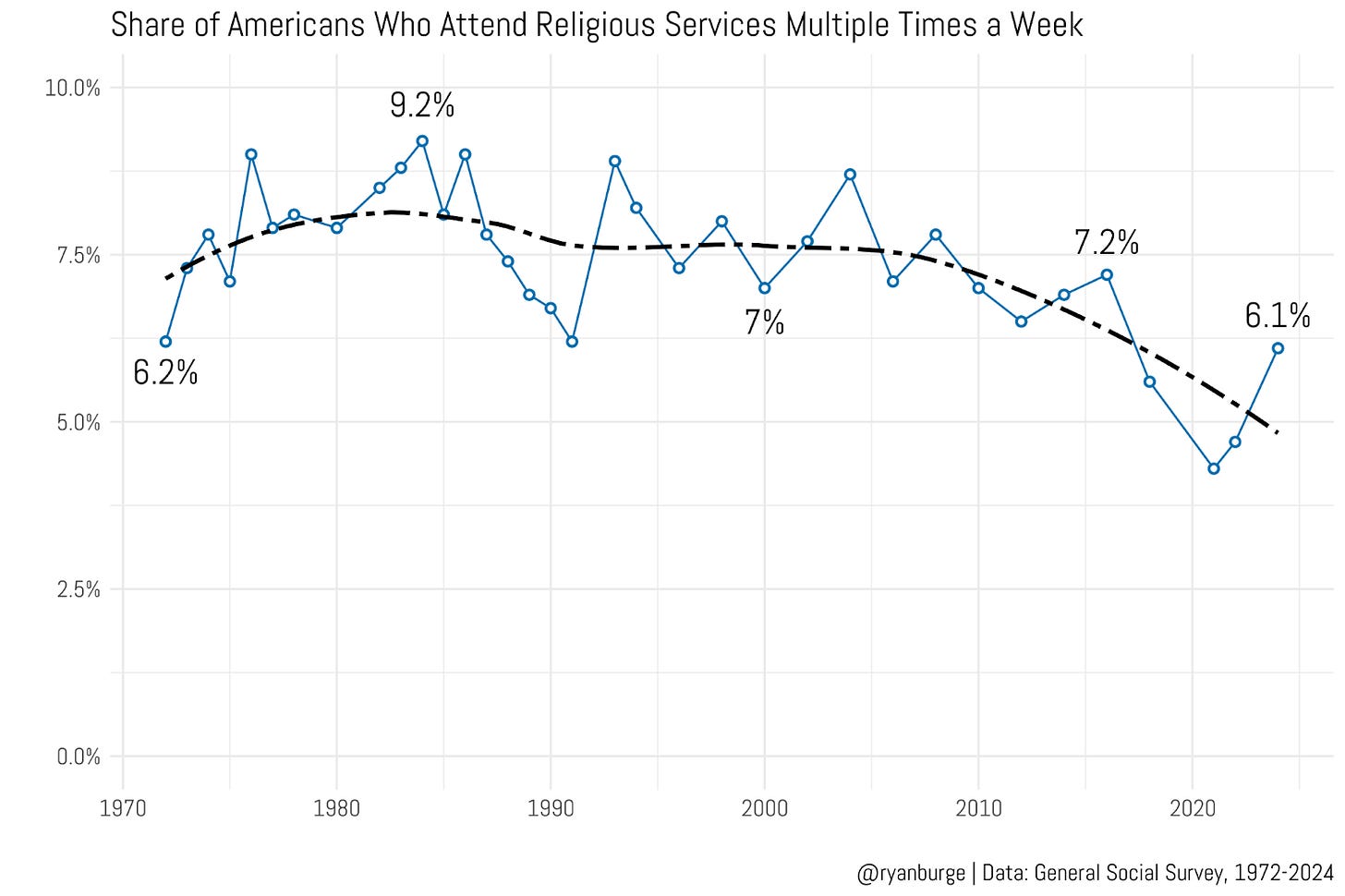


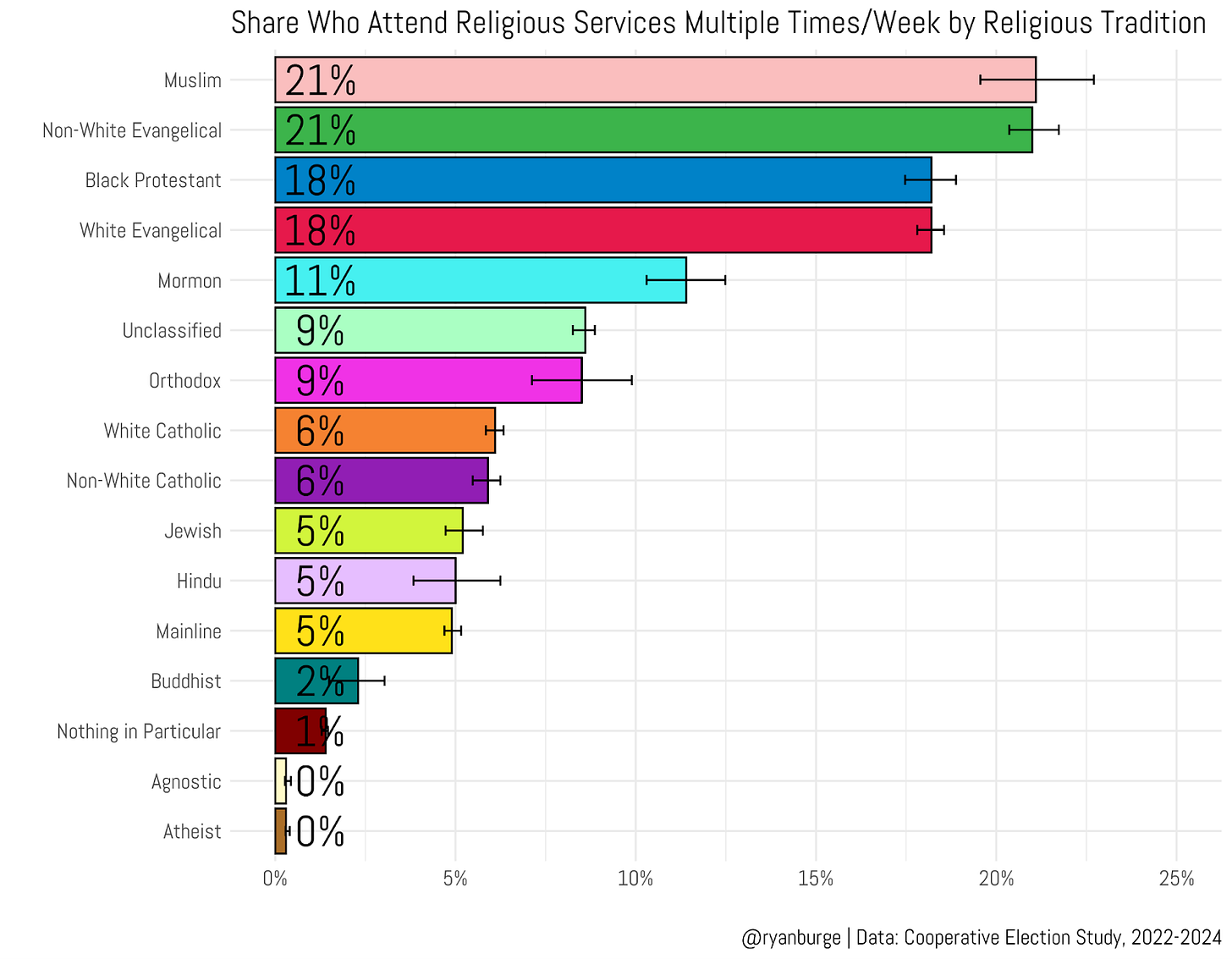

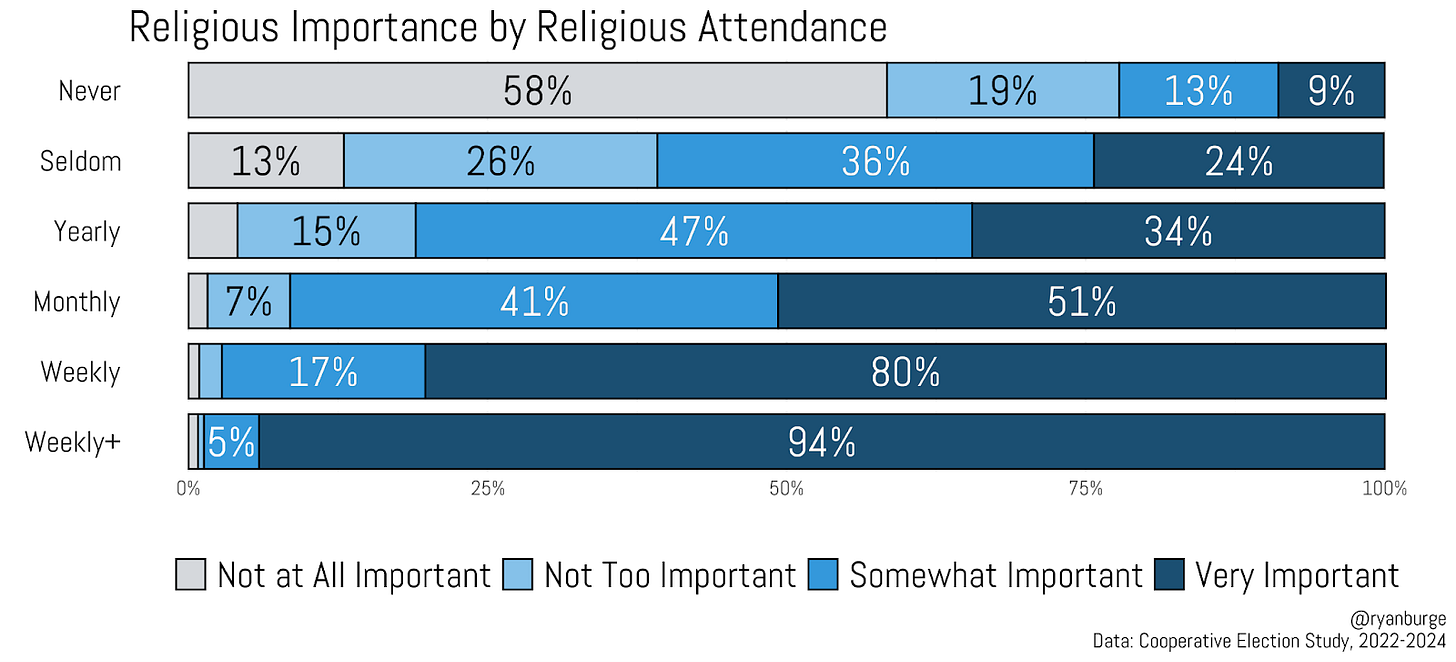
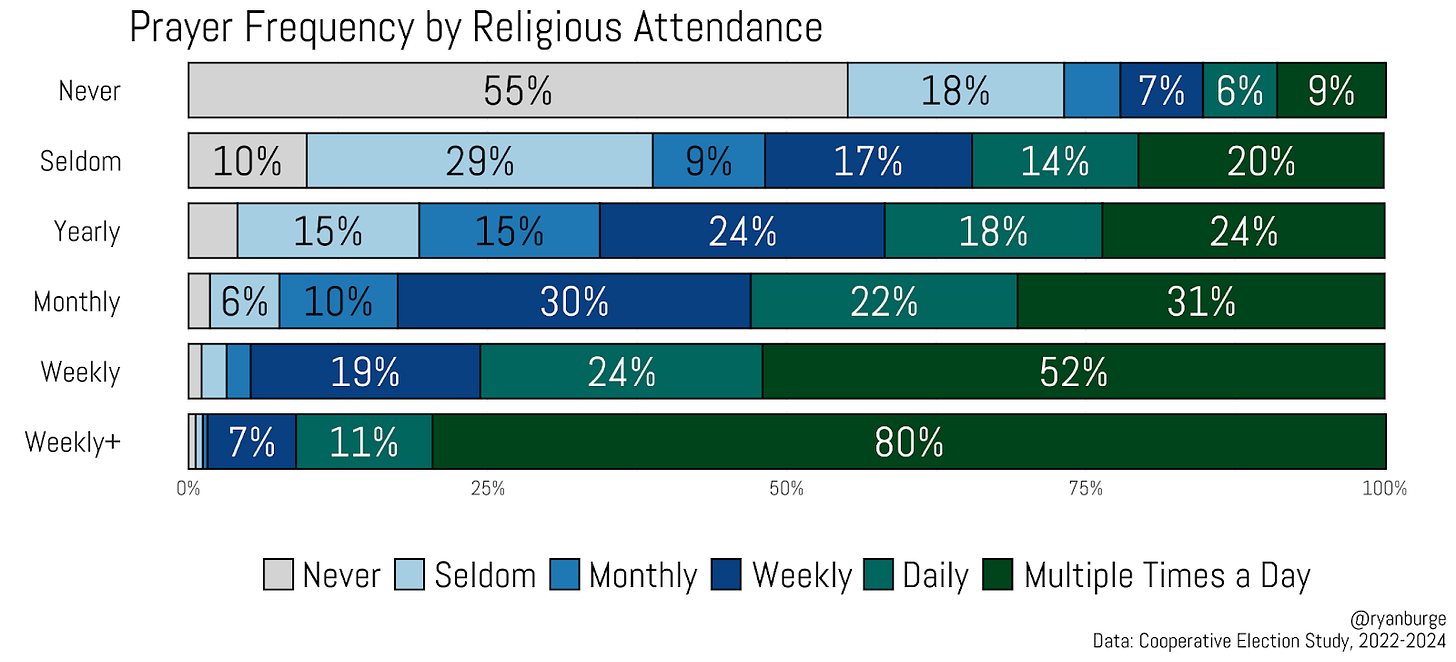
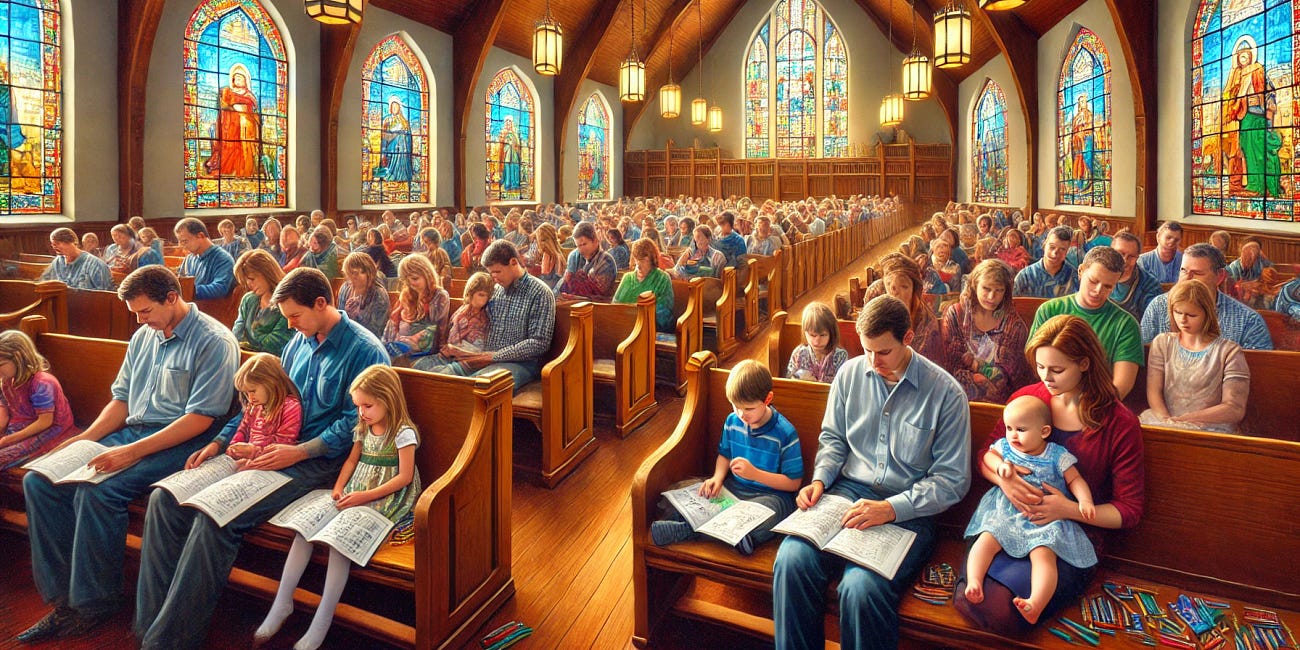

As someone that grew up White Evangelical Weekly+, it's nice to see that my feelings of piety over people that didn't come on Wednesday nights were justified 🙃
LDS follow an explicitly “home-centered, church-supported” devotional and learning pattern. There are activities (especially for youth) and callings often require meetings or service at other times, but there isn’t any study group or “religious service” to “attend” other than on Sunday morning.